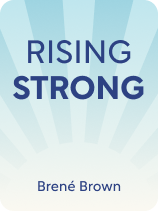
What’s an emotional setback? What’s the proper way to get back on your feet after an emotional setback?
An emotional setback could be anything holding you back in life. You could’ve been broken up with, failed a big exam, or experienced a loss.
If you’re having trouble moving past a rough patch in your life, Brené Brown’s tips can help you.
The Importance of the Emotional Setbacks
In Rising Strong, Brown explains that emotional setbacks such as disappointment, grief, heartbreak, and failure are valuable, natural parts of life. Despite being painful, they’re an opportunity to develop emotional resilience, deepen your understanding of yourself and others, and grow. In turn, these benefits lead to a more stable state of wholeheartedness—but to reap them, you must confront your pain and undertake the process of recovery.
Brown says many people avoid confronting the recovery process and instead try to push through or ignore their pain. They do so because confronting strong emotions can be scary and painful. However, avoidance causes them to first repress their emotions, and then release them (often subconsciously) through unhealthy behaviors that harm themselves and others.
Here are a couple of tips for those trying to look ahead at a bright future.
1. Look Inward
Brown says to look inward and question why you reacted the way you did to an emotional setback. This will help you determine how to improve so you can recover from setbacks more easily, maintain wholeheartedness, and build resilience, which we’ll discuss in the final stage of the recovery process.
To do so, consider why you made these unfair assumptions—what underlying thoughts and beliefs caused you to reach your conclusions? For example, maybe you fear being abandoned by important people in your life. When your spouse canceled at the last minute, your fear was triggered, and your brain told you that they were abandoning you—this led you to immediately assume ill intent on their part.
2. Change Your Thoughts and Behaviors to Build Resilience
Brown explains that the final stage of the recovery process is to identify ways in which you can alter your thoughts and behaviors to avoid emotional setbacks in the future.
You’ll have uncovered problematic thoughts and beliefs that underlie your emotional setbacks and inhibit you from vulnerability and wholeheartedness. In this step, you must identify how you can change these thoughts and behaviors to avoid similar setbacks in the future.
To complete this stage, consider: What new, more positive narratives do you need to tell yourself to avoid making negative assumptions about yourself or others? What emotional wounds and beliefs do you need to overcome to improve your relationships, strengthen your self-worth, and create a happier, more fulfilling life for yourself? Every time you experience a new emotional setback and move through the recovery process, ask yourself these questions and determine which wounds to heal next.
For example, you’ve identified that your fear of abandonment triggered your emotional setback. To move forward and build resilience, you must identify ways to lessen the control that your fear has over your thoughts and behaviors. You might do this by catching yourself when you assume ill-intent from someone and trying to see the situation from their perspective. Further, you could work on forming more realistic expectations of others. It may not be realistic or fair to expect your spouse to attend your ceremony if they’re sick—you need to consider their needs, not just your own.
| Cognitive Behavioral Therapy to Facilitate Recovery Brown isn’t the first psychologist to emphasize the importance of overcoming negative automatic thoughts and behaviors and healing from past emotional wounds to live a happy and fulfilling life. This has been the focus of psychotherapy for centuries. In particular, cognitive behavioral therapy (CBT) is designed to accomplish the process Brown lays out in her final stage—overcoming negative automatic thoughts and behaviors by replacing them with more productive ones. In cognitive behavioral therapy, patients work with a professional to target the negative automatic thoughts that result in their emotional setbacks. They identify problematic thoughts and behaviors and come up with strategies to replace them with more positive or realistic stories. CBT may expedite the recovery process because while you’re encouraged to undergo much of the work on your own, your psychologist functions as a guide and means of support. They generally support you through six to 20 sessions. Once your therapy concludes, you should be able to implement the strategies on your own in your everyday life. |

———End of Preview———
Like what you just read? Read the rest of the world's best book summary and analysis of Brené Brown's "Rising Strong" at Shortform.
Here's what you'll find in our full Rising Strong summary:
- How to rebuild wholeheartedness after setbacks and recover emotionally
- Why you shouldn't try to push through or ignore emotional pain
- Brené Brown's three-stage recovery process to cultivate resilience






